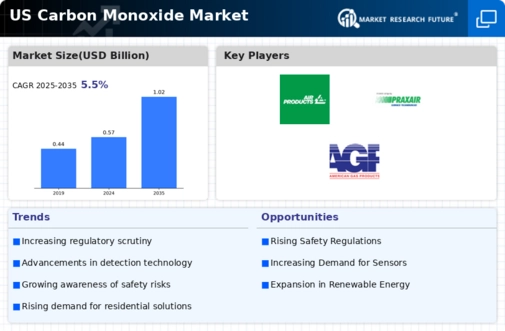Market Analysis
In-depth Analysis of US Carbon Monoxide Market Industry Landscape
The carbon monoxide (CO) market in the United States is undergoing dynamic changes driven by a combination of factors that influence both supply and demand. Carbon monoxide, a colorless and odorless gas, plays a significant role in various industries, from manufacturing and chemical processes to the production of specialty chemicals. The market dynamics are shaped by technological advancements, regulatory considerations, safety concerns, and the diverse applications of carbon monoxide.
One key dynamic in the U.S. carbon monoxide market is the increasing demand from industries that utilize the gas for various applications. Carbon monoxide is an essential component in the production of chemicals, such as methanol and acetic acid, as well as in metallurgical processes like the reduction of iron ore. The growth in manufacturing, chemical, and metallurgical industries contributes to the rising demand for carbon monoxide. Manufacturers are adapting to this demand by investing in efficient production processes to ensure a stable and reliable supply of high-purity carbon monoxide.
Regulatory considerations play a crucial role in shaping the market dynamics of carbon monoxide in the United States. The gas is subject to strict regulations to ensure safety, with organizations like the Occupational Safety and Health Administration (OSHA) setting standards for permissible exposure limits. Additionally, environmental regulations govern emissions from industrial processes where carbon monoxide is generated. Compliance with these regulations is a significant aspect for producers, influencing production practices and the overall structure of the carbon monoxide market.
Safety concerns surrounding carbon monoxide are another important factor influencing the market dynamics. Given its toxic nature, safe handling, storage, and transportation of carbon monoxide are paramount. Stringent safety protocols are in place to prevent accidental releases and ensure the protection of workers and the surrounding environment. As safety standards evolve, manufacturers and users of carbon monoxide must invest in technologies and practices that mitigate the risks associated with its production and application.
Technological advancements contribute to the dynamic nature of the U.S. carbon monoxide market. Innovations in production methods, such as advanced catalytic processes and gas separation technologies, enhance the efficiency and cost-effectiveness of carbon monoxide manufacturing. The development of cleaner and more sustainable production methods aligns with the broader industry trends toward environmentally friendly practices. Moreover, advancements in carbon monoxide sensors and monitoring technologies contribute to improved safety measures in various applications.
Competition within the market fosters innovation and efficiency in carbon monoxide production. Companies are constantly seeking ways to differentiate themselves by optimizing production processes, ensuring product quality, and offering reliable supply chains. The competitive landscape drives manufacturers to explore new technologies and methods to enhance the overall value proposition for customers across different industries.
The energy sector also plays a role in shaping the market dynamics of carbon monoxide in the United States. The gas is utilized in various energy-related applications, including the production of synthesis gas for use in power generation and as a feedstock for fuel cells. As the energy industry evolves with an increased focus on cleaner and more sustainable practices, the demand for carbon monoxide in these applications is likely to be influenced by the transition to renewable energy sources.
Socio-economic factors, including economic growth, industrialization, and infrastructure development, contribute to the market dynamics of carbon monoxide. As industries expand and new infrastructure projects emerge, the demand for carbon monoxide as an essential industrial gas is expected to grow. Economic trends and shifts in industrial activities influence the consumption patterns and requirements of carbon monoxide users.





Leave a Comment